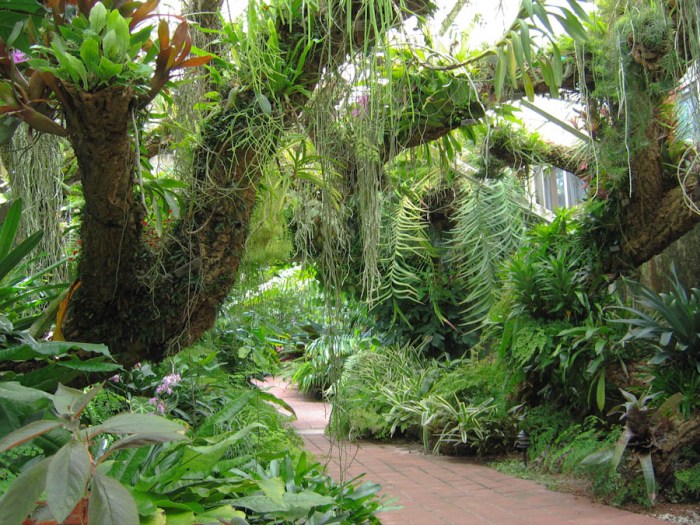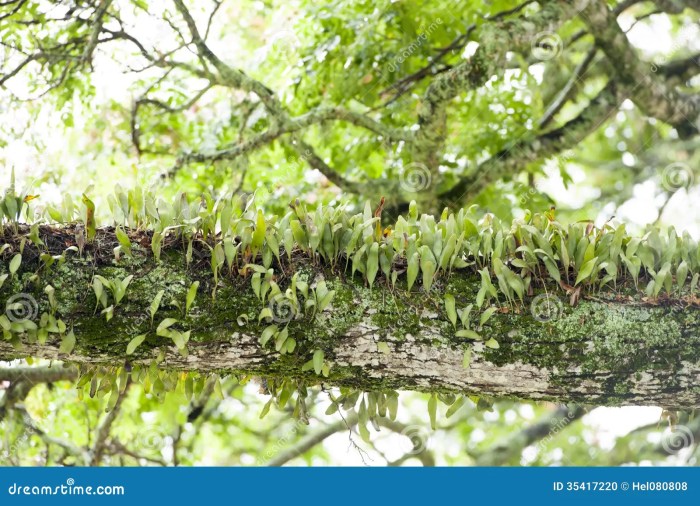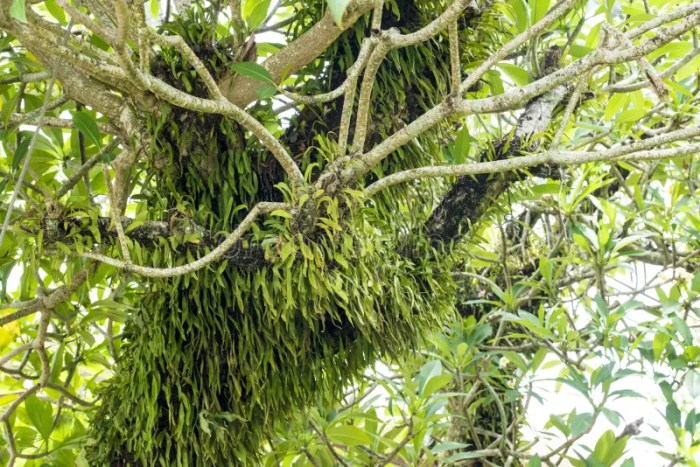Epiphytes growing on tropical trees exemplify the remarkable adaptations and ecological roles of these unique plants. As they cling to their arboreal hosts, epiphytes showcase the intricate relationships that shape tropical ecosystems.
Their ability to thrive in these challenging environments, their remarkable diversity, and their ecological contributions make epiphytes a fascinating subject of study.
Epiphyte Adaptations

Epiphytes, plants that grow on the surface of other plants without parasitizing them, exhibit remarkable adaptations that enable them to thrive in the diverse and dynamic environment of tropical trees. Their unique strategies for water and nutrient acquisition, as well as structural modifications for support and stability, have allowed them to flourish in this competitive ecosystem.
Water Absorption
Epiphytes have evolved specialized structures for absorbing water and nutrients from the air, rain, and decaying organic matter. They possess highly absorbent tissues, such as trichomes and velamen, that can rapidly capture moisture from the humid atmosphere. Additionally, many epiphytes have aerial roots that extend into the surrounding air, increasing their surface area for water and nutrient uptake.
Nutrient Acquisition
Epiphytes obtain nutrients from various sources, including decaying organic matter, rainwater, and dust. Some epiphytes have symbiotic relationships with nitrogen-fixing bacteria, which convert atmospheric nitrogen into a usable form. Others rely on the decomposition of organic matter that accumulates on their surfaces or in their root systems.
Structural Modifications
Epiphytes have developed a range of structural adaptations to withstand the challenges of their exposed environment. They often have sturdy stems or trunks that provide support and prevent them from being dislodged by wind or rain. Additionally, many epiphytes have specialized roots that anchor them securely to their host trees, preventing them from falling.
Epiphyte Diversity

Tropical ecosystems harbor an astonishing diversity of epiphytes, ranging from tiny mosses and ferns to large bromeliads and orchids. This diversity can be attributed to the wide range of habitats available on tropical trees, as well as the evolutionary adaptations that have enabled epiphytes to exploit these niches.
Growth Forms
Epiphytes exhibit a variety of growth forms, including epiphytic trees, shrubs, vines, and herbs. Epiphytic trees and shrubs have woody stems and may reach significant heights, while epiphytic vines and herbs have flexible stems that allow them to climb or trail along their host trees.
Habitats
Epiphytes can be found in various habitats on tropical trees, including the trunk, branches, and leaves. Some epiphytes prefer the moist, shaded understory, while others thrive in the exposed canopy. The distribution of epiphytes is influenced by factors such as light availability, humidity, and nutrient availability.
Ecological Roles

Epiphytes play crucial ecological roles in tropical forests, contributing to nutrient cycling, water retention, and providing habitat and food sources for other organisms.
Nutrient Cycling
Epiphytes contribute to nutrient cycling by capturing and recycling nutrients from the atmosphere and decaying organic matter. They accumulate nutrients in their tissues and release them slowly over time, enriching the forest ecosystem.
Water Retention
Epiphytes can absorb and retain large amounts of water in their tissues and root systems. This water retention helps to regulate the forest’s microclimate, reducing temperature fluctuations and providing a buffer against drought.
Habitat and Food Sources
Epiphytes provide habitat and food sources for a wide range of organisms, including insects, amphibians, reptiles, and birds. Their complex structures create microhabitats that support a diverse array of species. Additionally, many epiphytes produce flowers or fruits that serve as food for animals.
Conservation Challenges: Epiphytes Growing On Tropical Trees Exemplify

Epiphytes face numerous threats in tropical ecosystems, including deforestation, climate change, and pollution.
Deforestation
Deforestation is a major threat to epiphytes, as it destroys their habitat and disrupts the ecological processes they support. The loss of tropical forests has led to a decline in epiphyte populations and a reduction in their ecological functions.
Climate Change, Epiphytes growing on tropical trees exemplify
Climate change is also a significant threat to epiphytes. Changes in temperature, precipitation, and humidity can alter the microclimate of tropical forests, making them less suitable for epiphyte growth. Additionally, extreme weather events, such as hurricanes and droughts, can damage or destroy epiphyte populations.
Pollution
Pollution from industrial activities and agricultural runoff can harm epiphytes by contaminating their tissues and altering their physiological processes. Air pollution can reduce light availability and affect epiphyte photosynthesis, while water pollution can introduce toxins that can damage their tissues.
Questions and Answers
What are the unique adaptations that allow epiphytes to thrive on tropical trees?
Epiphytes have evolved specialized adaptations to survive on tree trunks and branches. These adaptations include specialized root systems for nutrient absorption, drought-tolerant leaves, and efficient water-storage mechanisms.
How do epiphytes contribute to the ecological balance of tropical forests?
Epiphytes play crucial roles in nutrient cycling, water retention, and providing habitat and food sources for other organisms. They also contribute to the overall structural complexity of the forest, creating microhabitats for a wide range of species.
What are the major threats facing epiphytes in tropical ecosystems?
Epiphytes are threatened by deforestation, climate change, and pollution. Deforestation directly removes their habitats, while climate change alters temperature and humidity levels, affecting their survival. Pollution can also damage their sensitive tissues and disrupt their symbiotic relationships.